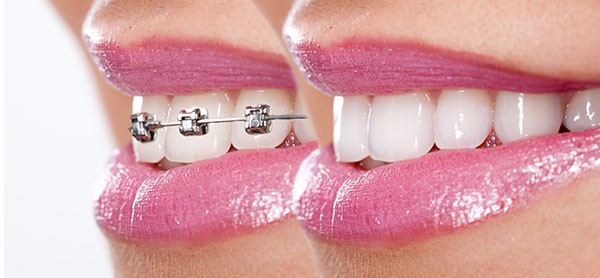
How Braces Work in Five Simple Steps
So, you decided to straighten your teeth, and get that healthy, confident smile you’ve always wanted. You visited your orthodontist who explained the process, but you still have questions about how these metal gadgets really work. Read on for an easy-to-follow explanation!
1) Braces are fancy handles with four basic parts.
- Brackets(metal or ceramic) are attached to each tooth.
- Bonding material(glue) attaches the bracket to the tooth.
- A thin metal archwire connects the brackets, putting pressure on your teeth.
- Ligature elastics (or “o-rings”) are the small, coloured ties that connect the brackets to the arch wire. These are usually changed at each visit.
2) Got it. But, how do these tools make my teeth move?
The teeth move when the archwire puts pressure on the brackets and teeth. Sometimes, springs or rubber bands are used to pull in a specific direction. Braces exert constant pressure, which over time, move teeth into their proper positions.
3) Yeah, but how does this happen?
Gums surround your teeth. Under the gums is a membrane that “holds” the root portion of your tooth that is surrounded by bone. When braces put pressure on your teeth, this membrane stretches on one side and compresses on the other, allowing movement of the tooth. The bone changes and grows to support the tooth’s new position.
4) How much force does this take?
Only some force, not normally present, is needed to make these small movements over time. The brackets and archwires create and sustain the pressure. Here’s how:
The initial archwires want to retain their normal shape. When they are flexed into the brackets, this provides the forces necessary for bone remodeling to begin. The strategic placement of brackets on your teeth, and the tying of those brackets to the archwire, maps out the steps. Once your teeth are closer to perfect, your orthodontist (and this is where the know-how comes in!) makes precise, calculated bends in a different type of wire to finish the work.
Cool fact: The heat produced by your body activates the metal that the initial archwires are made from!
5) So, how long does all this remodeling take?
Teeth move about one millimeter per month, so depending on what needs to be fixed, most patients need braces for somewhere between 6 months and 3 years. Average is about two years.
6) This all makes sense but what is that thing called a “retainer”?
A retainer supports your teeth in their newly aligned positions. Teeth naturally move and sometimes want to shift into their old spots after treatment. Remember, the bone they sit in is a living, growing thing and it may still need a bit of time to adapt to the changes in your mouth. Even after your braces come off, it may take some time for your teeth and bones to stabilize. Sometimes a retainer is simply a fixed wire behind your teeth, which cannot be seen. Other times it’s a clear, plastic removable tray that fits the exact shape and placement of your teeth. Your orthodontist may advise you to wear your retainer all day, every night or every few days, depending on your case. Sometimes, a retainer is even used for mild tooth movement but it does not have the same precision as braces.
